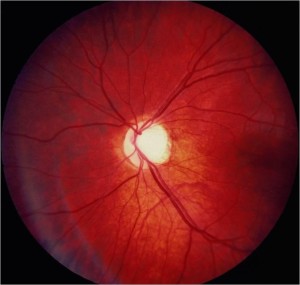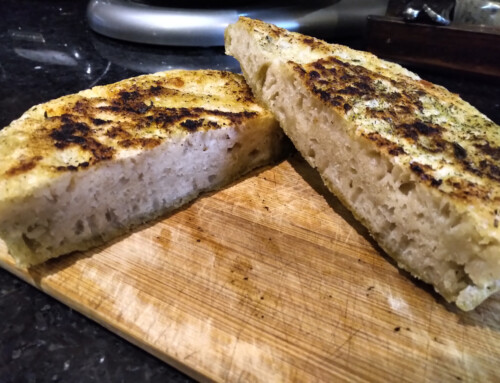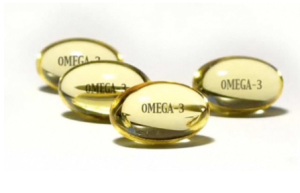 Omega 3 Foods Differ
Omega 3 Foods Differ
Omega 3 foods and supplements include many. In fact, Omega 3 supplements could take up several book cases in the health food store. Due to the Omega 3 source, the processing, cooking or food preparation, and our digestive function, the Omega 3 foods will make a difference to our health in a variety of ways, one of which, is how we efficiently absorb them. How we absorb them would make a difference to how effective they would be on our health.
Learning about important Omega 3 foods is more vital these days, due to the amount of information readily available, and how they are highly recommended by many doctors and various healthcare practitioners. One needs to take into account that there are entire books written about healthy fats and Omega 3s, in addition to, a whole chapter in hundreds of health books.
Out of 100 people, more than 60% said they feel they get enough Omega 3 from foods.
In 2014, I conducted a survey. Out of 100 people, more than 60% said they feel they get enough Omega 3 from foods. Why are people then testing for a deficiency in long chain Omega 3s (i.e. DHA and EPA) and significant imbalances between the ratio of Omega 3 and Omega 6?
Have you noticed Omega 3s listed on food packages? Have you noticed the amount of advertising for Omega 3 nutritional supplements? Dr. Jan Dadson shared with me ‘even the veterinarians are overwhelmed on hearing from Omega 3s salesmen’ as pets need them too. Let’s explore what Omega 3s are, the different sources and how the balance of Omega 3 to Omega 6 is vitally important for your health. And finally, how the Omega 3 foods differ.
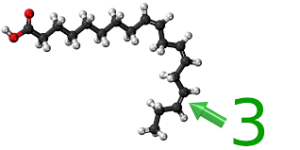 Omega 3s
Omega 3s
Omega 3s, better known as Essential Fatty Acids (EFAs), are vital for our health. They are essential because our bodies do not produce them. We need to get Omega 3s from our foods/whole food supplements.
Omega-3 oils are a type of polyunsaturated fat and the healthiest fat you can eat. There are three types of fat in a typical diet: saturated fat with comes mainly from animal sources and includes cheese, butter and red meat; mono-unsaturated fat which is found in olive oil; and polyunsaturated fat, which is found in seafood, nuts, meat and many edible vegetable oils, particularly sunflower and corn oil. There two most significant types of polyunsaturated fat (also referred to as polyunsaturated fatty acids (PUFAs) or essential fatty acids) are Omega-3 and Omega-6 fatty acids. These two are further divided into short-chain (18 carbons and less) and long-chain (20 or more carbons). The body is unable to naturally produce either of these so they have to be obtained from the foods we eat. — Seafish Guide UK
EFAs are found in our cell wall membranes therefore they are instrumental in the following:
- letting nutrients in and materials/metabolic waste out of the cell, along with keeping things in the cell and out of the cell
- creating new cells
- communicating with other cells
- communicating with the environment
- storage of energy/information for the above functions
For some doctors and researchers, the cell membrane is referred to as the ‘brain of the cell’ (not the DNA). It is worth noting that Omega 6s are also EFAs and essential. In my opinion, just as vital as Omega 3s, hence more about this under balance.
Types of Omega 3s
Omega 3s are typically referred to as:
- ALA which is found in plant and short chain,
- EPA and DHA which are found in sea plants, fish, Krill, and
- DPA more recently discovered in mammals, such as the blubber of the harp seal.
The Omega 3 DPA is a mammalian source. Our bodies and the blood contain DPA, and breast milk is natural source of DPA (docosapentaenoic acid.)
Importance of Omega 3 Foods and Supplements
Omega 3s are not all created equal which is mostly due to the processing of foods, but also taking into account, if our bodies are able to convert the shorter chain Omega 3s to a longer chain. The research indicates the key importances of Omega 3s for our health to be the following:
- play a role in anti-inflammatory processes
- viscosity of cell membranes
- pregnancy and fetal development
- healthy aging
- precursors of several metabolities
- eye and retina health
- beneficial in the prevention or treatment of several diseases (including cancer and allergies)
- brain and nerve health (i.e. Alzheimer’s, Diabetic Neuropathy)
- general cardiovascular health
- and more
For ‘The Top 10 Diseases Related to Omega 3 Deficiency’, click here.
There are two key areas to understand before moving on. The body’s ability to convert short chain Omega 3s to long chain Omega 3s is limited according to research, the range varying from <.01% to 10% with the lower being more likely. The second area, is the increased requirements we have today to reduce inflammation (which is part of every disease, pain, infection and injury) which comes from nutritional deficiencies, stress and toxins/chemicals. It would seem from the food processing progress and Western society habits, we are exposed to all of them regularly. It is known that stress comes from both physical and mental.
Omega 3s Listed on Foods
Omega 3s are on food packaging because they are vital for our health, and with being a part of every cell, GLOBAL in our body. Doctors and healthcare practitioners often recommend Omega 3 to patients to lower inflammation which is part of every disease – including cancer, diabetes, arthritis, etc. With this importance comes the need to market such essential nutrients like Omega 3s on packaging.
Omega 3s listed on foods containing vegetable oils such as canola, soybean, sunflower, etc., is the highly processed cheap refined plant form of Omega 3s that is not effective in our bodies. Refining includes heat, bleaching and deodorizing.
Several years ago, consumers would have found Omega 3 listed on many cereals and grain products due to the vegetable oils in the foods. The vegetable seed oils were shown to be unhealthy Omega 3s (highly processed). Now, you will see Omega 3s listed on chia seeds, hemp hearts, walnuts, eggs, etc. – those foods that are a source of healthy Omega 3s. Of course, you will see Omega 3s on all Omega 3 containing nutritional supplements. I hear there is also an Omega 3 drug.
Omega 3 foods include vegetables, seeds, nuts, grains, animal products, eggs, seafood, and many other foods. But are Omega 3 foods enough? People are deficient in Omega 3s according to researchers and their testing.
“Inadequate LC-Omega-3 [long chain] is today’s greatest unrecognized deficiency disease,” says Jack Winkler, Professor
On one hand, Omega 3 foods is good for marketing companies’ food products, and on the other hand, the quality of the Omega 3 foods and supplements may determine how effective they are for us.
What about the ratio of Omega 3 to Omega 6?
 Omega 3 to Omega 6 Ratio
Omega 3 to Omega 6 Ratio
Omega 3 foods will most likely contain both Omega 3 and Omega 6. According to fat usage, the critical ratio of Omega 6 to Omega 3 may not be in your favour for optimum health and for managing inflammation. Omega 3 and Omega 6 are both healthy fats as long as these omegas are closer to an equally balanced 1:1 ratio. When you consume corn oil the ratio is approximately 60:1 Omega 6 to Omega 3.
“A century ago, the Omega 6 in our diet comprised .2% of our caloric intake, whereas today it has reached the dangerous level of around 20%. Add to that the decrease of Omega 3 in our diet due to current farming and production methods, and the 1:1 ratio of Omega 6 to Omega 3 that is required for our health becomes distorted, far too often blood intakes are measuring as high as 20:1 or more.” Referenced Source
When looking at the recommended ratio across many references where the ratio is from 1:1 to 4:1 Omega 6 to Omega 3, 20:1 is not as favourable for managing inflammation, where inflammation has been well established as part of every disease.
Ratio Research
Simopoulos AP (PubMed, US National Library of Medicine National Institutes of Health link) shares in his abstract:
- In the secondary prevention of cardiovascular disease, a ratio of 4/1 was associated with a 70% decrease in total mortality.
- The ratio of 2.5/1 reduced rectal cell proliferation in patients with colorectal cancer, whereas a ratio of 4/1 with the same amount of omega-3 PUFA had no effect.
- A ratio of 2-3/1 suppressed inflammation in patients with rheumatoid arthritis.
- A ratio of 5/1 had a beneficial effect on patients with asthma, whereas a ratio of 10/1 had adverse consequences.
I am stressing that the quality of the foods be top priority along with this the balance of nutritional food, for example, other fats, proteins, vitamins, minerals, etc. For instance, if you are taking hemp oil then freshly pressed or grinded hemp hearts would be ideal. For people taking a fish oil, take an Omega 3 supplement derived from small fish due to the accumulation of toxins. If the consumer decides to take a mammalian source (harp seal), then try a seal oil supplement that is not refined (Auum Canada Inc.) as all others are refined.
Omega 6 to Omega 3 Ratio List
From my research and calculations, here is a short list of foods and the documented ratios (numbers may vary due to diet of animal, location of plants, etc.)
Omega 6:Omega 3 Ratio for Omega 3 foods – please note that the amount of omegas contained in the food is not listed here. Turkey fat contains 10 times more Omega 6 than butter oil but with the same amount of Omega 3 (mg per 100 g). Fish and seafood values are not listed because the Omega ratios were not in line with some published research.
- Almonds 2009:1
- Avocado oil 13:1
- Beef, grass-fed and Bison 4:1
- Beef, grain-fed 10:1
- Butter oil 2:1 (will vary by animal’s diet)
- Canola oil 2:1 (highly refined, GMO)
- Cashews 48:1
- Chia 1:3
- Cocoa butter 28:1
- Corn oil 46:1
- Duck breast, wild 51:1
- Eggs, whole scrambled 13:1
- Fish oil on average 10:1
- Flax seed* 1:4
- Grape seed oil 696:1

- Hemp oil 4:1
- Pumpkin seed oil 3:1
- Seal oil from harp seal blubber 1:1
- Sesame oil 138:1
- Soybean oil 7:1
- Sunflower high oleic 70% 19:1
- Turkey fat 15:1
- Venison 2:1
- Walnuts 4:1
- Note: almond oil, coconut oil, safflower oil are Omega 6 only and peanut and wheat germ oil are not recommend
- Note: Omega 3 foods are easily oxidized when exposed to air, light and heat*
Let’s explore the change in ratios over the past 100 years and how anti-inflammatory drugs is a top selling drug.
From Krispin Sullivan
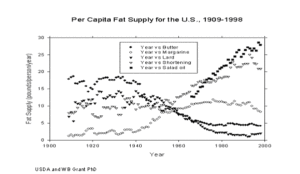 Between 1903 and 1998 added fats rose from 34 pounds per person per year, mostly butter and lard, to more than 66 pounds per person per year. All of the fat increase was in the form of omega-6 as salad dressing, margarine, shortening and hydrogenated fat added to processed foods and candies. See the charts that follow.
Between 1903 and 1998 added fats rose from 34 pounds per person per year, mostly butter and lard, to more than 66 pounds per person per year. All of the fat increase was in the form of omega-6 as salad dressing, margarine, shortening and hydrogenated fat added to processed foods and candies. See the charts that follow.
Research suggests our n-6:n-3 ratio in traditional cultures was 2-3:1 or even 1:1. Currently the dietary ratio in the US is calculated n-6:n-3 20-50: 1. As n-6 fatty acids are precursors to inflammatory processes in the human body and n-3 fatty acids precursors to anti-inflammatory processes it does explain the 75 million prescriptions for anti-inflammatory drugs each year and the $1.7 billion spent on over the counter anti-inflammatory medications. Globally NSAID sales topped $11.4 billion in 2014. We are in pain. We need good food and good fats.
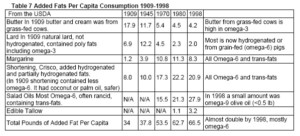
The ratio of omega-6 to omega-3 in the U.S. diet is somewhere between 25-50:1. The ideal ratio is somewhere between 3:1-1:1. [source]
Omega 3 Foods, Research and Diet Changes
According to the USDA (United States Department of Agriculture), since 1909 butter PUFAs usage has decreased by 99.9% whereas salad oil usage has increased by over 1042%. [source:download spreadsheet] These values are indicative of a decrease in mammalian PUFAs and an enormous increase in salad oil PUFAs.
Krispin, Peskin and many many others, all talk about the same thing – the importance of enough healthy fats, the right kind of healthy fats (changes over the past 100 years, charts) and the ratio of Omega 6 to Omega 3 for managing inflammation. Dr. Peskin provides in his book ‘The Hidden Story of Cancer’, the published studies that generated a negative effect from taking fish oils (Disclaimer: I do not know what fish oils they used).
The choice is ours to learn enough about Omega 3 foods so we can make educated decisions. It is as much about what you add into to your nutrition or diet, as it is about what you eliminate from your nutrition or diet.
Considerations
- Eliminate all foods with refined vegetable/salad oils in them (including canola, hydrogenated or partially hydrogenated fats), organic or not
- Consume whole foods which contain the natural fat content such as whole milk and full fat yoghurt or hemp hearts instead of hemp oil
- Fresh, raw, dry roasted, sprouted nuts and seeds in moderation
- Good quality mammalian fat sources such as grass-fed beef or on their natural diet like venison or wild game
- Replace your salad dressings with cold (ice) pressed organic olive oil, pumpkin seed oil, etc. – read the labels (see Simple Salad Dressings)
- For baking, use the butter or ghee, never margarine or butter substitutes. Ghee or clarified butter do not contain casein or lactose
- For future moms or pregnant women, nature’s perfect food for baby is the breast milk, something that set us mammals apart from reptiles/dinosaurs/fish
From the first food, the baby is experiencing the nutritional value in the mother’s milk or if formula (for whatever reason) then considerations of how to provide the proper nutrition is still a function of the quality of the food and in either case, follow the considerations.
My Experience
With my experience and research since 2008, I write on healthy fats and Omegas due to their vital importance on our health.
I consume a variety of Omega 3 foods, such as, grass-fed butter, ghee, walnuts, hemp hearts, pumpkin seed oil, algae, greens, grass-fed beef, eggs from chickens running free (omnivores – show the chickens the worms!), etc. Regarding supplements, my family uses Auum Omega 3, a mammalian source.
Go for quality plus notice if your Omega 3 supplement of choice is working for you. When I switched from fish oils to mammalian oils, I noticed a change in one day and with my holistic practice, I have witness changes for people of all ages – from 5 minutes to one hour, from 1 day to one week, from 1 month to one year – everyone is unique. It depended on how much the person took to how long they held the oil under their tongue to if they chose to take the oil in capsule form. These days therapeutic dosing is considered and effective to manage acute or chronic inflammation – how much does the water have to rise to make a waterfalls flow?
 Final Words
Final Words
Other areas around fats to further explore is oxidation (rancid oils) and the types of Omega 3s in various foods, hence sticking to good quality and a variety of Omega 3 foods is a good idea – but not so when it comes to breast milk, nature’s perfect food for baby (up to 6 months+), this is the mother’s doing. 🙂
Generally speaking, consuming healthy fats both in quantity and quality would address deficiencies and internal toxicity. First add important Omega 3 foods to your daily diet, then consider a good quality Omega supplement especially if you are managing any inflammatory conditions. You may want to even explore an Omega 6:Omega 3 ratio test. In ending, it is clear that a healthy balanced ratio of Omegas plus a bigger picture view is optimum for our health – nutrition, sleep, activity and attitude.
For your better health,
Cheryl
Resources
http://advances.nutrition.org/content/3/1/1.long
http://www.seafish.org/media/Publications/SeafishGuidetoOmega3HealthClaims.pdf
http://www.fda.gov/Food/NewsEvents/ConstituentUpdates/ucm394855.htm
http://lipidworld.biomedcentral.com/articles/10.1186/1476-511X-10-145
Omega 6 to Omega 3 Ratio https://www.ncbi.nlm.nih.gov/pubmed/12442909

Cheryl Millett
Champion for your better health…



